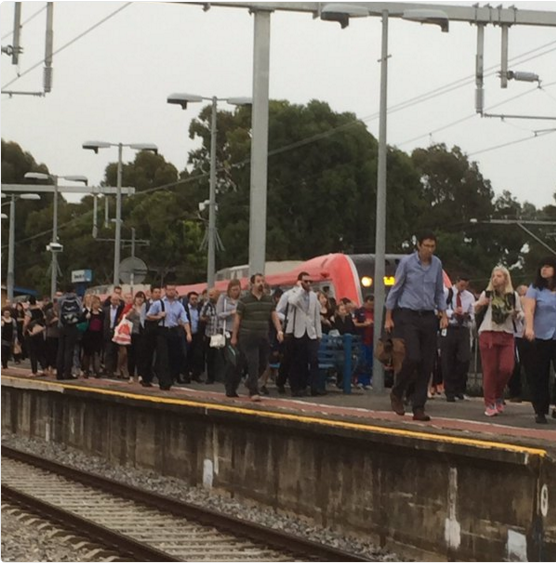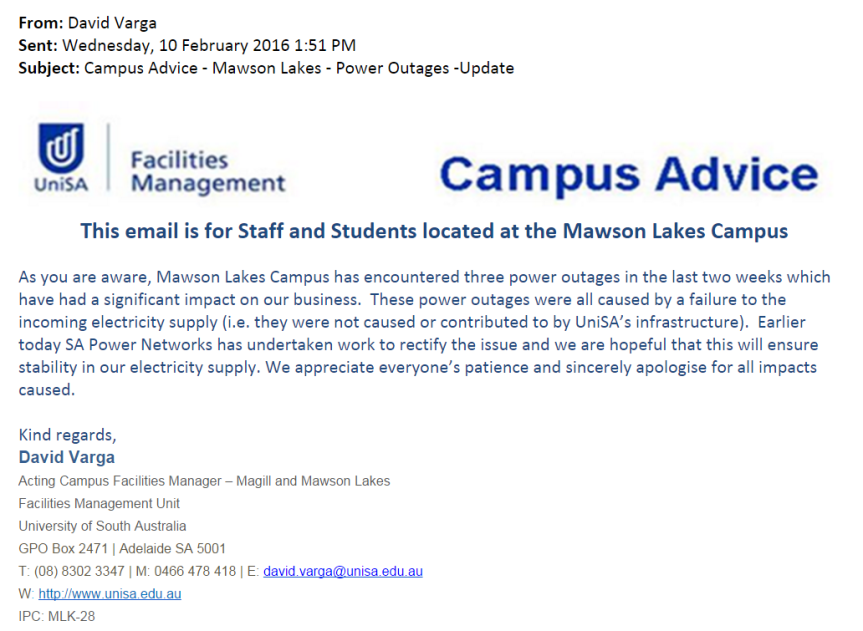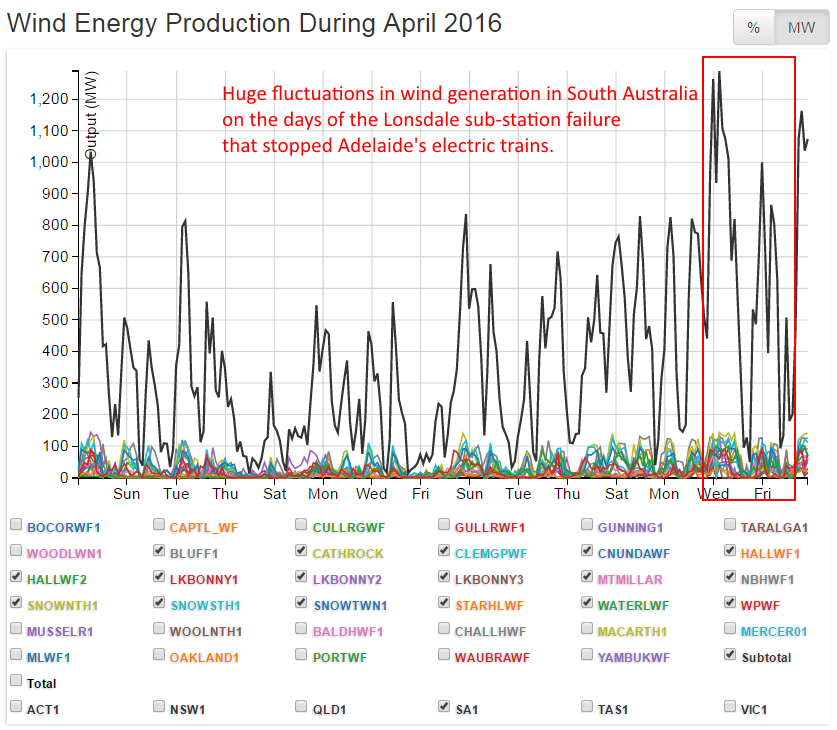South Australia’s wind powered economy is a picture of reliability (see above and below).
In its capital, Adelaide, for 2 days in row (28 and 29 April) thousands of hopeful commuters were left to their own devices, as wild variations in wind power output wrecked the power supply to its Seaford/Tonsley electric train line.
We’ll hand over briefly to what passes for journalism in SA to get (as usual) half of the story.
Free ride to pay for train line closure
Tim Williams
Sunday Mail
1 May 2016
TRAIN passengers who use the lines affected by the electric rail shutdown on Thursday and Friday will ride for free one day this week as compensation.
A fault with a circuit breaker on the Seaford line produced a power outage that caused chaos for commuters on the Seaford and Tonsley lines, with knock-on effects on the Grange line, forcing many to rely on substitute buses or old diesel trains.
Transport Minister Stephen Mullighan yesterday repeated his thanks to commuters for their patience.
“We not only provided some free services (on Friday), substitute services, but we are intending to have a free travel day for those affected lines coming in the week,” he said.
Mr Mullighan said teams of engineers from his department and contractor Siemens were reviewing the “highly unusual” power outage at the Lonsdale substation, where both primary and secondary power feeds failed. An independent investigator will also be appointed.
Mr Mullighan said it was normally possible to switch “seamlessly” between the two power feeds, as had been done four times in the past year.
“Yes, a circuit-breaker did fail but that’s what they are designed to do. It’s highly unusual that separate power feeds coming in from separate parts of the SA Power Networks electricity network were unavailable at the same time.”Mr Mullighan said taxpayers would not have to foot the bill for repairs. Siemens would be asked to fix the substation and prevent future outages.
Sunday Mail
So just how “highly unusual” was the power outage suffered? And what caused it?
South Australia is referred to as Australia’s ‘Wind Power Capital’. Its 1,477MW of wind power capacity is said to equate to around 40% of total generating capacity (a figure soon to increase if Alinta’s Port Augusta Power Plants close, as threatened).
With its attempt to rely on the weather for power, SA has witnessed Statewide blackouts – when wind power output collapses on a total, and totally unpredictable basis: Wind Industry’s Armageddon: Wind Farm Output Collapse Leaves 110,000 South Australian Homes & Businesses Powerless
And short of complete collapses, SA’s grid has become increasingly unstable, with massive and wild fluctuations in wind power output wrecking the security of supply (not to mention the small matter of rocketing power prices).
South Australians are learning to live with daily ‘load-shedding’, that – as we reported previously – even its premier academic institutions have to suffer, along with thousands of other businesses and households. This telling little email from UniSA’s management was flicked to us by one of our SA operatives (who just happens to be an engineer):
The source of the “failure to the incoming electricity supply” was, as our engineer contact informs us, all about ‘grid instability’, caused by SA’s chaotic, intermittent and unreliable wind power supply.
Our contact also tells us that UniSA’s Mawson Lakes campus (located north of Adelaide and south of Salisbury) had been experiencing frequent supply ‘interruptions’ and wholesale blackouts for months prior to the email notice above. Air-conditioners no longer functioned; lectures were cancelled; the campus would go into “lock-down”; and the power surges and erratic supply damaged electrical equipment and appliances, as well as distribution systems on campus.
The cost of repairing or replacing appliances, equipment or electrical systems – due to erratic wind power supplies (and the power surges, grid instability and consequent grid management chaos that comes with intermittent wind power) – is just another cost that gets brushed aside by one-eyed wind-worshippers.
So too the cost of having thousands of commuters stranded: a result due to the entirely erratic output from wind power, which has turned an otherwise stable supply – essential to run electric trains (and everything else we rely on, for that matter) – totally feral (as we detail below).
But first, some technical stuff.
What commuters on the Seaford/Tonsley line experienced last month (and will continue to experience) is part and parcel of trying to integrate an entirely weather dependent generation “system” into electricity grids designed to operate in a steady, stable state.
In the video that follows, an electrical engineer, Andrew Dodson explains in detail the lunacy of trying to distribute wind power via a grid deliberately designed around on-demand generation sources. STT recommends it to anyone with even the vaguest interest in how our electrical grid works (and that must now surely include the Seaford/Tonsley line’s ‘occasional’ commuters!).
At the simplest level, think of our distribution grid as akin to a mains water distribution system. In order to function, the pipes in such a system need to be filled at all times with a volume of water equal to their capacity and, in order to flow in the direction of a user, the water within the pipes needs to be maintained at a constant pressure.
Where a household turns on a tap, water flows out of the tap (in electrical terms “the load”); at the other end an equal volume of water is simultaneously fed into the system and pumps fire up to maintain the pressure within it (although gravity often does the work).
In a similar fashion, an electricity grid can only function with the required volume of electricity within it; maintained at a constant pressure (voltage) and frequency (hertz) – all of which fluctuate, depending on the load and the input.
What Andrew Dodson makes crystal clear is that these essential certainties (essential, that is, to maintaining a stable and functioning electricity grid) have been tipped on their head, as a result of the chaos delivered by wind power.
****
****
What Andrew has to say about wind power, in general, has special pertinence to Australians, not just South Australians.
The Federal Coalition government helped lock in a $45 billion electricity tax – which is to be directed at wind power outfits; and for no other purpose than to help them spear another 2,500 of these things all over the country.
And more so with Labor’s ‘Electricity’ Bill Shorten crowing louder than ever about a ludicrous 50% RET, the number would need to be in the order of 10-12,000 of them. Never mind the cost; and never mind what happens to the stability of the grid.
As Andrew Dodson points out, grid stability (frequency and load balancing) matters. Back in 2012, Australia’s Paul Miskelly (another highly experienced Electrical Engineer) ripped into the patent nonsense of wind power in his paper Wind Farms in Eastern Australia – Recent Lessons – published in the journal, Energy and the Environment. On the risk to grid stability from attempting to integrate intermittent and highly variable wind power output into Australia’s Eastern grid, Paul wrote:
PROPERTIES OF ELECTRICITY GRIDS
On an electricity grid supply and demand must be maintained in balance on a second-by-second basis (AEMO, [6]). Kirby et al [7], for example, in discussing these fundamental concepts, state:
“Small mismatches between generation and load result in small frequency deviations. Small shifts in frequency do not degrade reliability or markets efficiency although large shifts can damage equipment, degrade load performance, and interfere with system protection schemes which may ultimately lead to system collapse.”
Bevrani et al [8] discuss control parameters and strategies in detail and stress that any degradation of electricity grid control system safety margins will result in frequent, unscheduled, widespread blackouts (“system collapse”). A recent German government report highlights the likely catastrophic consequences resulting from any such event.
In South Australia, wind power output fluctuations (rapid surges and precipitous collapses) mean that “the [massive] mismatches between generation and load result in [huge] frequency deviations” – with “widespread blackouts”; which has “degraded load performance”, and led to a dangerously unstable power supply.
STT’s operatives inform us that the wide range in supply voltage caused by wind fluctuations has seen the grid managers in SA (SA Power Networks) reduce the voltage running in the grid to 220 Volts (the Australian Standard is 240). Ordinarily, the system is set to operate at 230 Volts, allowing for normal – load driven – fluctuations above and below that level, such that the upper limit never exceeds 240. Surges above 240 Volts put appliances (especially electronics) at risk of permanent damage. Now, with massive wind power surges a daily feature of SA’s power supply, the grid operator is faced with frequent and rapid rises in voltage; and has adjusted the operating voltage downwards to accommodate it.
What appears below – courtesy of the boys over at Aneroid Energy – explains why.
During April, SA’s wind power output was, as usual, up and down like the proverbial Yo-Yo:
Now, let’s take a closer look at the ‘performance’ of SA’s 17 wind farms (with a notional capacity of 1,477MW) on 28 and 29 April – the days that the Seaford/Tonsley line ground to a halt.
On both days wind power output surged from a trickle to a deluge and back again.
On 28 April, output rockets 950MW (50 to 1,000) in around 9 hours. From Noon to 14:00 there is a surge of around 350MW (50 to around 380). Then, having hit around 380MW – in the span of a few minutes – there is a 150MW collapse and almost instantaneous surge. After which there follows a series of surges and falls for the rest of the afternoon.
On 29 April, there is a 750MW collapse before breakfast (1,100 to 350) and, as bleary eyed Seaford/Tonsley line commuters were heading for their nearest platforms, a 450MW surge (350 to 800) in less than 60 minutes from 6.30am.
From Noon to 6.30pm, output collapses by over 850MW (over 900 to around 30). After 3pm, around the time hundreds of school kids were lining up for a ride home, wind power output plummets from around 500MW to a piddling 30MW – a grid killing collapse of 470MW in the space of a couple of hours.
The putative “fault with a circuit breaker on the Seaford line” was all about an erratic power supply. There is, and was, nothing wrong with the substation, as claimed.
The grid, the switching gear and the substations that direct power within it are all (as explained above) designed to operate at narrow voltage and frequency tolerances.
The circuit breaker that tripped did no more than what it was designed to do: namely to shut off the supply in response to voltage surges or drops – and the consequent under- or over-loading – that would have caused permanent damage to lines, substations and the trains themselves. Here, the system protected itself, in the same way that the circuit breakers in your home trip when faced with an abnormal load.
Electricity grids are, by definition, ‘systems’ and they’re not (and were never) designed to tolerate the abuse delivered by power generation sources that can throw 450MW into a grid without any notice; or, conversely, to rip 150MW out of it, in a matter of a few minutes (see 28 April at 14:00) or nearly 500MW over an hour or two.
South Australians are reaping what was sown by its then Premier, Mike Rann back in 2002. With his Labor Party successors pushing for a 50% renewable target, the Seaford/Tonsley line’s hopeful commuters can expect a whole lot more of the same. Welcome to your wind powered future.







Highly unusual outage? We had a massive one a year or so back that blacked out most of the North of Scotland. An unusual weather pattern that meant one minute the wind was blowing a hoolie and the next still followed by another blast of air all within a twenty minute time span caused a breaker to trip at Knocknagael sub station. As anyone in the power industry will tell you once one trips the inability to balance supply creates a cascade effect with others downstream tripping to protect the system. Getting back on line with each breaker manually reset took days. An unusual outage in an area reliant on wind. No, entirely predictable and well documented, if not in the official versions. The intermittency of wind and the vagaries of our weather dictate it will happen again. The local electricity company has spent millions rigging new automatic breakers to reduce the impact but who pays for that? The Consumer in the end. We pay for their entirely foreseeable errors and to protect their profits.
I have no sympathy for the residents of South Australia. They have consistently elected politicians that have pursued the global warming alarmist ideological cause, and in so doing they have dismantled South Australia’s industrial base and destroyed jobs en-masse, as well as pushing their State into bankruptcy.
If the citizens of South Australia had any brains then they would be out on the streets every weekend in tens of thousands demonstrating against the incompetence and gullibility of their politician’s ridiculous attempts to change the global temperature by less than one hundredth of a degree in two hundred years time. You couldn’t be much more stupid than that. This is especially in view of the fact that empirical science just does not support the climate alarmist proposition that CO2 is evil. All the scientific evidence is available in the public domain to demonstrate the futility of the alarmist claims, but is ignored by the mainstream media. In democracies such as ours the power to do something about incompetent or politically dishonest politicians is simply to throw them out of office. If the citizens of SA don’t do that then they deserve what they get.
Actually we did vote in the other side, but the electoral boundaries prevented them gaining government.
Reblogged this on UPPER SONACHAN WIND FARM.
I certainly hope that one Matthew Wright, who was representing Beyond Zero Emissions at the time, reads the above post STT.
Back in 2012, not only did he try to ambush the Penshurst (Victoria, Australia) Community meeting to discuss the nightmare RES (UK) wind farm proposal to build more than 220 turbines just to the south of the town. But he and RES also loudly proclaimed that the grid in South Australia was running beautifully! He is seen stating this in Part 2 below at around 2mins 50secs into the clip where RES hand him the microphone.
And just how was he rewarded for this bad behaviour? He appeared on the ABC Drum soon after!
Penshurst meeting Part 1
Penshurst meeting Part 2
I can just see Siemens fixing this supply fault at no cost to the taxpayers. just after the pigs fly off home.
Two reasons for saying this. Supply faults are not Siemens concern. They belong to the SA Government. There is nothing in the Siemens sub station equipment that can mitigate load /supply mismatches. SA had better start reinstating some coal stations or there will not be sufficient power to do the welding necessary on the new submarines let alone manufacture any of the steel to be welded.
I say we power all the coffee shops in Fitzroy exclusively with wind power and see how long the latte sippers last before there is an outcry.
perfect idea. also the vegan cafes etc wind/solar only – see how they like eating their garden in the dark
It seems apparent that there will be no ‘disaster’ big enough for journalists, government officials or even power retailers in South Australia that they will ever link to the nonsense of intermittent unreliable wind power generation. We can only hope that people and authorities in the other Australian states will not be so blind to reality or so stupid as to deny the ‘causal link’ that is staring them in the face. The ‘cover up’ in South Australia would be a crime if not for government mandate.